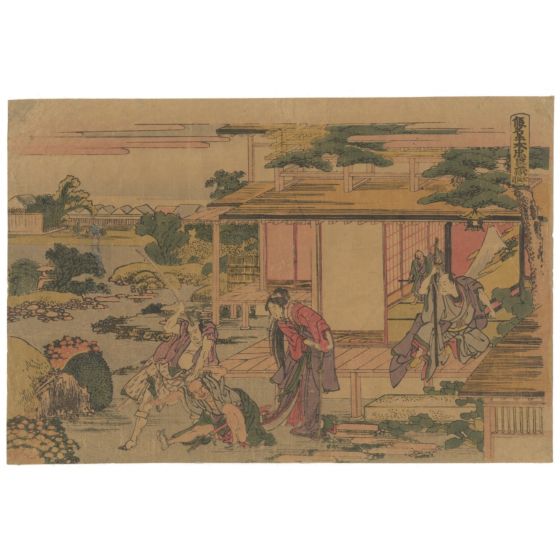Hokusai Katsushika, Chushingura, Act VII, Loyal Retainers
Artist: Hokusai Katsushika (1760-1849)
Title: Act VII
Series: Kanadehon Chushingura
Publisher: Tsuruya Kinsuke
Date: 1806
Dimensions: 38.6 x 26 cm
Original Japanese woodblock print.
Kanadehon Chushingura, the story of fourty seven retainers, is one of the greatest tales about loyalty and revenge in Japanese history. It is closely based on a historical event from the eighteenth century.
While preparing for the visit of the Emperor's ambassador in Edo Castle, one of the noblemen, Lord Asano of Ako, provoked by countless insults, drew his sword on another lord, wounding him inconsiderably. However, as drawing a weapon in the palace was strictly prohibited, Lord Asano was sentenced to commit seppuku (ritual suicide by disembowelment). His property was confiscated and his samurai dismissed, making them rōnin, or masterless warriors. Thereafter, the rōnin avenged their master by killing the enemy and putting his head on the grave of Lord Asano. The story ends with honourable death by seppuku of the faithful samurai.
In Act VII, the leader of the rōnin, Yuranosuke, stays at the Ichiriki Tea House in Gion. Being in disguise, he pretends to lead a debauched life in order to divert any suspicion by the enemy away from the revenge plan. He is so successful that even some of his men are convinced that he has given up. At night, he leaves the house to read a secret letter, yet he finds out he is being spied on by one of the enemies and a geisha called Okaru. Yuranosuke plans to kill them both, however, he realises Okaru's sincerity, and lets her live. Moreover, they dispose of the spy by drawing him out of his hiding place and stabbing.
Hokusai introduces the last scene of the act. Yuranosuke raises his hand to inflict a deadly blow, while Okaru stands beside him with her katana, patiently waiting for her turn. The other samurai approach from within the tea house. A peaceful Japanese garden greatly contrasts with the vicious event depicted in the forepart.
Hokusai Katsushika
Hokusai Katsushika is considered to be one of the greatest artists within Japan as well as the entire art community worldwide. While prints of beautiful women (bijinga) and prints of actors (yakusha-e) were popular in the ukiyo-e during that time, Hokusai distinguished himself in a new field in ukiyo-e, landscapes. Born in Edo (today’s Tokyo), he initially trained as an engraver. At the age of 18 he became a student of Katsukawa Shunsho (1726-1792) producing kabuki actors prints.
Hokusai devoted almost all of his 90 years of life to drawing and painting. Never satisfied with one technique or mastering one style of drawing, he always sought to improve as an artist. In the mid-1810s, the first volume of ‘Hokusai’s Manga’ was published. This series of sketchbooks consists of 15 volumes in total, covering a wide variety of subjects and is often referred to as a series of instructional drawing manuals intended to serve as a kind of textbooks for those who wanted to become artists.
In the early 1820s, Hokusai started working on the series ‘Thirty-six Views of Mt. Fuji’, which was finally published in 1830. It is certainly his most famous body of work and is often considered his best. The series actually consists of 46 images, with designs such as ‘The Great Wave off Kanagawa’, ‘Fine Wind, Clear Weather’, and ‘Rain Storm Beneath the Summit’, known worldwide. His other famous series ‘A Tour of the Waterfalls of the Provinces’ also appeared around this time period. In the mid-1830s, his illustrated book ‘One Hundred Views of Mt. Fuji’ was published. Filled with depictions of the mountain in often dynamic compositions, this book, alongside ‘Thirty-six Views of Mt. Fuji’, established Hokusai as the ‘Mt. Fuji artist’.
His last major print series, 'One Hundred Poems Narrated by the Nurse', was published between 1835 and 1838. After that, the artist focused on Japanese traditional paintings until his death.
Hokusai used over 50 names to sign his works and had achievements in various fields as an artist. His influences stretched across the globe to his western contemporaries in nineteenth-century Europe with Japonism, which started with a craze for collecting Japanese art, particularly ukiyo-e. He influenced the Impressionism movement, with themes echoing his work appearing in the work of Claude Monet and Pierre-Auguste Renoir, as well as the Art Nouveau style.
| Print Format | Oban (Horizontal) |
|---|---|
| Artist | Hokusai Katsushika |
| Subject | Samurai & Male, Male & Female, Landscapes |
| Dimensions | 38.6 x 26 cm |
| Condition Report | Residue paper and glue from the previous mounting. Restored hole one the centre left. |
| Publisher | Tsuruya Kiemon, Kinsuke |







